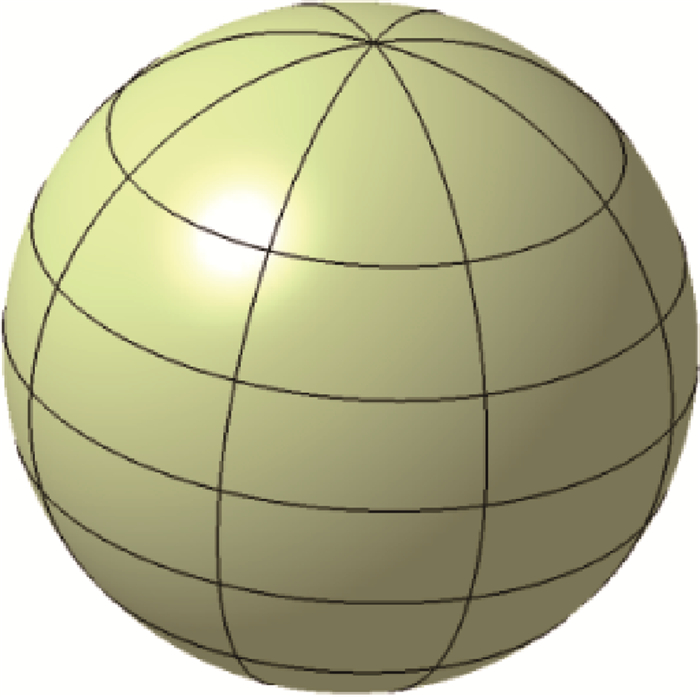Optimization of aerostat helium temperature differences between day and night based on Kriging model
-
摘要:
分析浮空器氦气昼夜温差时通常将整个囊体蒙皮涂层设置为同一种材料,分析材料的吸收率与发射率对氦气昼夜温差的影响。为进一步减小氦气昼夜温差,提出了将囊体分为迎光面和背光面,迎光面采用吸收率低的材料,背光面采用发射率高的材料。建立了囊体热力学模型,采用Kriging模型对囊体不同部位的材料特性进行优化,其基本思想是将囊体划分为48个部分,采用拉丁超立方体方法进行抽样,进行热力学分析得到样本的响应,以此建立Kriging近似模型。经过该方法优化后发现,氦气的昼夜温差减小到28.6 K,比传统的分析减少7.7%。
Abstract:Considering the entire skin coating of aerostat envelop materials as one material, the effect of absorption and emission rate of aerostat envelop materials on helium temperature differences between day and night is investigated. In order to further reduce helium temperature differences between day and night, in this paper, aerostat envelop materials are divided into illuminated side with materials of low absorption rate and backlight side with materials of high emission rate. Under the established thermal analysis model, material properties in different parts of aerostat envelop materials are optimized with the method of Kriging model. It holds the thoughts that aerostat envelop materials can be divided into 48 parts, Latin hyper-cube method is used to do sampling, and sample response can be obtained through thermal analysis so as to build a Kriging approximate model. As the result, it shows that the helium temperature difference between day and night is reduced to 28.6 K, which is 7.7% less than the traditional ways of analysis.
-
表 1 云遮系数对太阳辐射的影响
Table 1. Influence of cloud cover coefficient on solar radiation
条件 太阳直接辐射强度 地面反射辐射强度 H>Hc QD, real =QD QRef=[C2ρg+(1-CF)ρc]·(QD+ QAtm) H<Hc QD, real =CQD QRef=Cρg(QD+ QAtm) 注:Hc—云层高度;ρc—云层反射率。 表 2 浮空器参数
Table 2. Parameters of aerostat
参数 数值 直径/m 30 面积/m2 2 826 体积/m3 14 130 飞行高度/km 20 飞行时间 6月21日(夏至日) 飞行纬度/(°N) 40 表 3 常用材料的热辐射特性参数
Table 3. Thermal radiation characteristic parameters of common materials
材料 η ε 白色PVF 0.25~0.40 0.75~0.90 白色PU 0.35 0.8~0.9 镀银Teflon 0.10~0.25 0.5~0.8 表 4 样本点1的吸收率
Table 4. Absorption rate of sample point 1
编号 吸收率 1 0.34 2 0.23 3 0.12 4 0.36 5 0.23 6 0.13 7 0.43 8 0.32 9 0.24 10 0.14 11 0.10 12 0.49 13 0.35 14 0.18 15 0.25 16 0.26 17 0.18 18 0.47 19 0.42 20 0.48 21 0.17 22 0.37 23 0.29 24 0.45 25 0.39 26 0.33 27 0.25 28 0.28 29 0.46 30 0.19 31 0.38 32 0.28 33 0.41 34 0.42 35 0.12 36 0.16 37 0.28 38 0.11 39 0.31 40 0.28 41 0.18 42 0.37 43 0.27 44 0.12 45 0.41 46 0.23 47 0.26 48 0.18 -
[1] NISHIMURA J.Scientific ballooning in Japan-An view of recent activites[J].Advances in Space Research, 2006, 37(11):2005-2014. doi: 10.1016/j.asr.2005.03.053 [2] COLOZZA A, DOLCE J L. High-altitude, long-endurance airships for coastal surveillance: NASA/TM-2005-213427[R]. Washington, D. C. : NASA Glenn Research Center, 2005. [3] ANDROULAKAKIS S P, JUDY R A. Status and plans of high altitude airships program[C]//Aerodynamic Decelerator Systems Technology Conferences. Reston: AIAA, 2013. [4] LEE Y G, KIM D M, YEOM C H.Development of Korean high altitude platform systems[J].International Journal of Wireless Information Networks, 2006, 13(1):31-42. doi: 10.1007/s10776-005-0018-6 [5] 刘东旭, 杨永强, 吕明云, 等.蒙皮热辐射特性对平流层浮空器氦气温度影响[J].北京航空航天大学学报, 2010, 36(7):836-840.LIU D X, YANG Y Q, LÜ M Y, et al.Effect of envelop thermal radiative properties on the stratospheric super-pressure LAT vehicle helium temperature[J].Journal of Beijing University of Aeronautics and Astronautics, 2010, 36(7):836-840(in Chinese). [6] WU J T, FANG X D, WANG Z G, et al.Thermal modeling of stratospheric airships[J].Aerospace Sciences, 2015, 75:26-37. doi: 10.1016/j.paerosci.2015.04.001 [7] DAI Q M, FANG X D, LI X J, et al.Performance simulation of high altitude scientific balloons[J].Advances in Space Research, 2012, 49(6):1045-1052. doi: 10.1016/j.asr.2011.12.026 [8] 方贤德, 王伟志, 李小建.平流层飞艇热仿真初步探讨[J].航天返回与遥感, 2007, 28(2):5-9.FANG X D, WANG W Z, LI X J.A study of thermal simulation of stratospheric airships[J].Spacecraft Recovery and Remote Sensing, 2007, 28(2):5-9(in Chinese). [9] LIU Q, WU Z, ZHU M, et al.A comprehensive numerical model investigating the thermal-dynamic performance of scientific ba-lloon[J].Advances in Space Research, 2014, 53(2):325-338. doi: 10.1016/j.asr.2013.11.011 [10] LIU Q, LI Z J, YANG Y C, et al. Thermal simulation and expe-riments for a stratospheric balloon gondola[C]//AIAA Modeling and Simulation Technologies Conference. Reston: AIAA, 2015, 6: 325-338. [11] LI D F, XIA X L, SUN C.Experimental investigation of transient thermal behavior of an airship under different solar radiation and airflow conditions[J].Advances in Space Research, 2014, 53(5):862-869. doi: 10.1016/j.asr.2013.12.032 [12] XIA X L, LI D F, SUN C, et al.Transient thermal behavior of stratospheric balloons at float conditions[J].Advances in Space Research, 2010, 46(9):1184-1190. doi: 10.1016/j.asr.2010.06.016 [13] 夏新林, 李德福, 杨小川.平流层浮空器的热特性与研究现状[J].航空学报, 2009, 30(4):577-583.XIA X L, LI D F, YANG X C.Thermal characteristics of stratos-pheric aerostats and their research[J].Acta Aeronautica et Astronautica Sinica, 2009, 30(4):577-583(in Chinese). [14] YAO W, LU X C, WANG C, et al.A heat transient model for the thermal behavior prediction of stratospheric airships[J].Applied Thermal Engineering, 2014, 70(1):380-387. doi: 10.1016/j.applthermaleng.2014.05.050 [15] KENYA H, KUNIHISA E, MASAAKI S, et al. Experimental study of thermal modeling for stratospheric platform airships[C]//AIAA's 3rd Aviation Technology, Integration, and Operations(ATIO) Conference. Reston: AIAA, 2003, 5: 74-89. [16] SIMPSON T W, MAUERY T M, KOPTEE J J, et al.Kriging models for global approximation in simulation based multidisciplinary design optimization[J].AIAA Journal, 2001, 39(12):2233-2241. doi: 10.2514/2.1234 [17] TOAL D J J, BRESSLOFF N W, KEAN A J.Kriging hyperparameter tuning strategies[J].AIAA Journal, 2008, 46(5):1240-1252. doi: 10.2514/1.34822 [18] LIU J, HAN Z H, SONG W P. Efficient kriging-based optimization design of transonic airfoils: Some key issues: AIAA-2012-0967[R]. Reston: AIAA, 2012. [19] HAN Z H, LIU J, SONG W P, et al. Surrogate-based aerodynamic shap optimization with application to wind turbine airfoils: AIAA-2013-1108[R]. Reston: AIAA, 2013. [20] 张柱国, 姚卫星, 刘克龙.基于进化Kriging模型的金属加筋板结构布局优化方法[J].南京航空航天大学学报, 2008, 40(4):497-500.ZHANG Z G, YAO W X, LIU K L.Configuration optimization method for metallic stiffened panel structure based on updated Kriging model[J].Journal of Nanjing University of Aeronautics and Astronautics, 2008, 40(4):497-500(in Chinese). [21] 肖立峰, 张广泉, 张以都.基于进化Kriging代理模型的结构形状优化方法[J].机械设计, 2009, 26(7):57-60.XIAO L F, ZHANG G Q, ZHANG Y D.Optimization method of structural shape based on Kriging surrogate model[J].Journal of Machine Design, 2009, 26(7):57-60(in Chinese). [22] 周秀骥, 陶善昌, 姚克亚.高等大气物理学(上册)[M].北京:气象出版社, 1991:85-95.ZHOU X J, TAO S C, YAO K Y.Advanced atmospheric physics(Ⅰ)[M].Beijing:China Meteorological Press, 1991:85-95(in Chinese). [23] FARLEY R E. BalloonAscent: 3-D simulation tool for the ascent and float of high-altitude balloons[C]//AIAA's 5th Aviation, Technology, Integration, and Operations (ATIO) Conference. Reston: AIAA, 2005. -








 下载:
下载:







